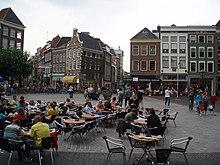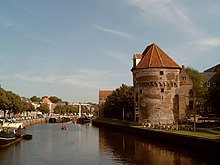Zwolle
 flag |
 coat of arms |
| province |
|
| mayor | Peter Snijders ( VVD ) |
| Seat of the municipality | Zwolle |
|
Area - land - water |
119.28 km 2 112.11 km 2 7.17 km 2 |
| CBS code | 0193 |
| Residents | 127,599 (Jan 31, 2019) |
| Population density | 1070 inhabitants / km 2 |
| Coordinates | 52 ° 31 ' N , 6 ° 5' E |
| Important traffic route |
|
| prefix | 038 |
| Postcodes | 8000-8043 |
| Website | Homepage of Zwolle |
Zwolle ( ), located near the IJsselmeer , is the capital of the Dutch province of Overijssel . In the area of Zwolle, the Zwarte Water , which is only 19 km long , is created, which then also directs the water of the Vechte ( Overijsselse Vecht ) into the Zwarte Sea . There is also a canal to the IJssel , the mouth of which is near the neighboring village of Kampen .
history
At the place where Zwolle lies, settlement remains from the Neolithic and the Bronze Age were found. The city was built on a small sand ridge (suol, compare German: swollen) between the IJssel and the Vecht. It was mentioned in a document as a Swoller brand as early as 1040.
Zwolle received city rights in 1230 , which were expanded in 1438 by stacking rights . As a free imperial city, it joined the Hanseatic League in 1346 and received the right to mint in 1488 . The 15th century was Zwolle's greatest heyday. Back then, like Deventer , the city was a stronghold of the art of printing . There were also educational institutions of great importance. The members of the Brothers of Common Life or Devotio moderna worked from Zwolle and Deventer across north-western Europe. During this time, Zwolle worked closely with the neighboring towns of Kampen and Deventer, and they even minted common coins for several decades.
In 1528 Zwolle recognized Charles V as lord. After about 1550 there was an economic decline, although the city always retained one of the largest cattle markets in the Netherlands and several printing shops. In 1580 the Catholics were expelled from the city, which at that time joined the States General . In 1672 she surrendered to the Bishop of Münster, Christoph Bernhard von Galen . In 1674 the fortifications were razed but soon rebuilt. Under the French rule at the time of Napoleon Bonaparte , Zwolle was the capital of the Bouches-de-l'Yssel department (department of the IJssel estuaries) at the beginning of the 19th century . New upswing in Zwolle occurred around 1890 when the city was connected to the railway network.
The Jewish community of Zwolle was decimated by deportations to German concentration camps during World War II . The city was liberated by the Canadian soldier Léo Major alone , which is why a street was named after him. There were also several executions of resistance fighters in the city. Some war memorials still commemorate these events.
Windesheim
The municipality includes the tiny, picturesque village of Windesheim, on the IJssel and on the road to Wijhe , five kilometers southeast of the city. In the Middle Ages it housed the important monastery of the same name, where Geert Groote and Thomas von Kempen worked in the community of Brothers of Common Life or Devotio moderna . The Canons of Windesheim founded numerous reform monasteries in Germany, such as the Böddeken monastery . The bones of Thomas von Kempen are in the Roman Catholic Basilica of Our Lady of Zwolle . The monastery chapel (15th century) has been preserved to this day. The area around the village is suitable for a bike ride over the IJssel dike.
Transport, economy
Zwolle is located on the Rijksweg 28 motorway and on the Amsterdam / Utrecht - Meppel - Groningen / Leeuwarden railway line . There are also rail connections with Deventer / Arnhem ; Ommen / Hardenberg / Emmen ; Raalte / Almelo ; Kampen.
The most important industries include:
- the service sector (provincial administration, many offices, courts, universities, a large hospital);
- the electrical, textile, food and paint industries as well as the metal processing industry and a large printing plant;
- the IJsselcentrale power plant south of the city on the IJssel river. It has its own inland port and is one of the largest power stations in the Netherlands;
- tourism with increasing importance;
- Dairy farming in the area.
Town twinning
- The German city of Lünen has been twin town of Zwolle since 1963.
- In 1980, the international city association Neue Hanse was founded in Zwolle , to which the city belongs.
Blaufinger (Blauwvingers)
The residents of Zwolle are also called Blaufinger (Blauwvingers). In the Middle Ages there was a real rivalry between the neighboring cities of Zwolle and Kampen - traders from Zwolle were robbed, the cattle of the Kamper farmers were stolen.
The Zwollers had a dirty name for the people from Kampen: Kamper Störe (Kampersteuren). This species of fish was still found in the IJssel at that time. The Zwollers only got their bad name when Zwolle offered the carillon from a church tower destroyed by fire to the Kamper neighbors for sale. The campers agreed to the amount of the requested purchase price, but on the condition that they could determine the method of payment themselves. One day wagons full of “four duiten stukken”, coins of very low value, arrived from Kampen in Zwolle. The Zwollers got blue fingers from counting all the loose change. “Blauwvingers” therefore became a dirty name for the Zwollers.
Nowadays the Zwollers no longer view this term so negatively. Every year in July there are Blue Finger Days on Wednesdays. Then there is market and other entertainment for residents and visitors to the old Hanseatic city.
Attractions
The Thorbeckehuis , birthplace of Thorbecke
- The Sankt-Michaels-Kirche was built between 1370 and 1446 in the Gothic style and has a Schnitger organ. It is open to visitors from May to mid-October.
- The Liebfrauenkirche from the 14th / 15th centuries Century has a tower, which is called Peperbus ("Pfefferbüchse") because of its top and is a symbol of the city. It can be climbed at times.
- The town hall was built in the 15th century.
- The Sassenpoort (German: Sachsentor ) is a city gate that was built in 1408 and can partially be viewed from the inside.
- The Dominican monastery, which has existed since 1901
- The Provincial Museum has recently been expanded and restored and shows paintings, city history, archeology and temporary exhibitions of modern art.
- The Museum de Fundatie is a museum of fine arts with annual changing exhibitions.
- Synagogue , built in 1898/99
- Interesting old houses from the 17th and 18th centuries can be found on Thorbeckegracht and Melkmarkt, for example.
- The city park "Engelse Werk" is located on the other bank of the IJssel.
- In July there is the "Blauwvingerdag" on Wednesday, a large flea market (see above).
- The professional football club PEC Zwolle got a new stadium in 2009 .
Sports
In 2011, Zwolle hosted the European inline speed skating championships .
The city is also home to the professional football club PEC Zwolle , which rose to the top Dutch league, the Eredivisie , for the first time in 1978 and has belonged to it again since 2012 after several interruptions. In 2014 the club became Dutch cup winners .
VC Zwolle 's men's and women's teams play or have played in the highest Dutch volleyball league and have been Dutch champions several times.
Personalities
sons and daughters of the town
- Christianus Carolus Henricus van der Aa (1718–1793), theologian
- Marcel Beekman (* 1969), tenor
- Sepp van den Berg (* 2001), soccer player
- Gerard ter Borch (≈1617–1681), painter and draftsman
- Anna van der Breggen (* 1990), racing cyclist
- Herman Brood (1946–2001), rock musician and painter
- Eef Brouwers (1939–2018), journalist, director general and speaker
- Marije Brummel (* 1985), soccer player
- Jacob Theodoor Cremer (1847–1923), entrepreneur, diplomat and politician
- Jeroen Dubbeldam (* 1973), show jumper
- Kingsley Ehizibue (born 1995), football player
- André Goudbeek (* 1946), jazz and improvisation musician
- Max Huiberts (* 1970), football player
- Anco Jansen (* 1989), soccer player
- Barend Coenraad Petrus Jansen (1884–1962), chemist
- Gerrit Kalff (1856–1923), Netherlands artist
- Ton Koopman (* 1944), harpsichordist, organist, conductor and one of the pioneers of historical performance practice
- Peter Lankhorst (* 1947), politician (GroenLinks)
- Michel Mulder (* 1986), inline speed skater and speed skater
- Ronald Mulder (* 1986), inline speed skater and speed skater
- Arnoud Nijhuis (* 1989), paracycler
- Tooske Ragas (* 1974), presenter, pop singer and model
- Wilhelmus Marinus Cardinal van Rossum (1854–1932), Cardinal Prefect at the Roman Curia
- Joost van Schaik (* 1974), jazz musician
- André Smit (1916-2001), jazz trombonist
- Johan Rudolf Thorbecke (1798–1872), politician and state theorist
- Meinard Tydeman the Elder (1741-1825), legal scholar and historian
- Jeff Vermeulen (* 1988), racing cyclist
- Hugo Visscher (1864–1947), church historian, Reformed theologian and politician
- Gerrit Voges (1932–2007), football player
- Charlotte Wessels (* 1987), singer and songwriter
Honorary citizen
- Léo Major (1921–2008), Canadian soldier who liberated the city on his own in World War II
With a relationship to Zwolle
- Thomas a Kempis (1380–1471), Augustinian canon , theologian and spiritual writer, lived from 1399 until his death in the house of the brothers from living together in Zwolle
- Alanus de Rupe (1428–1475), Dominican and beatified Roman Catholic theologian
- Roelof Amsinck (1518–1585), mayor of Zwolle, ancestor of the Hamburg patrician family Amsinck
- Michael Minsky (1918–1988), singer and conductor, lived in Zwolle from 1978 until his death
- Jonnie Boer (* 1965), three star chef in Zwolle
Web links
- Website of the municipality (Dutch, English)
- Tourist information website (Dutch, German, English)
Individual evidence
- ↑ Benoeming burgemeester Zwolle. In: rijksoverheid.nl. Rijksoverheid, August 30, 2019, accessed October 4, 2019 (Dutch).
- ↑ Bevolkingsontwikkeling; regio per maand . In: StatLine . Centraal Bureau voor de Statistiek (Dutch)
- ↑ Zwolle . In: Meyers Konversations-Lexikon . 4th edition. Volume 16, Verlag des Bibliographisches Institut, Leipzig / Vienna 1885–1892, p. 1023.
- ↑ Zwolle . In: Universal Lexicon of the Present and Past . 4., reworked. and strongly increased edition, Volume 19: Weck – Zz and supplements , self-published, Altenburg 1865, p. 782 .
- ↑ The Maple Leaf, April 26, 1945: D-Day Chaud Sout, Stubborn Man, captures Zwolle on his own Hook
- ↑ regiocanons.nl
- ↑ Monument register: Monument number: 41723, Melkmarkt 41 8011 MB te Zwolle, http://monumentenregister.cultureelerfgoed.nl/php/main.php?cAction=show&cOffset=0&cLimit=25&cOBJnr=41723&oOrder=ASC&cLast=1&oFieldNr=41723&oOrder=ASC&cLastNUMs_RiCompon=ASC&cLastN23&oFieldNr & sProvincie = & sGemeente = & sPlaats = & sStraat = & sHuisnummer = & sPostcode = & sFunctie = & sHoofdcategorie = & sSubcategorie = & sOmschrijving = & ID = 0 & oField = OBJ_RIJKSNUMMER













